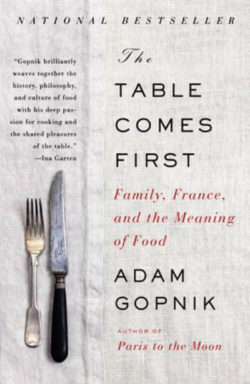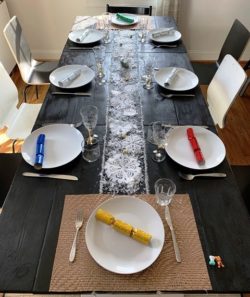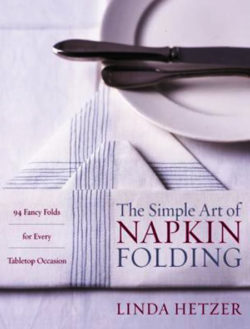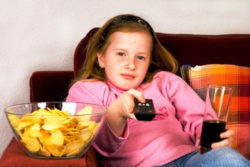Read Time: 5 Minutes Subscribe & Share
A Most Important Piece Of Furniture
Fergus Henderson, the inspiring chef (I share his love for offal) behind the famed St John Restaurant in London, once lamented in Adam Gopnik’s book,  The Table Comes First, “I
The Table Comes First, “I  don’t understand how a young couple can begin life by buying a sofa or a television. Don’t they know that the table comes first?” His woe hints at a bigger issue: the difference between eating and dining, whose distinctions seem to have faded with the passing of generations. But they are clearly distinct. Just look at the two definitions in your standard dictionary:
don’t understand how a young couple can begin life by buying a sofa or a television. Don’t they know that the table comes first?” His woe hints at a bigger issue: the difference between eating and dining, whose distinctions seem to have faded with the passing of generations. But they are clearly distinct. Just look at the two definitions in your standard dictionary:
To eat is to put food into the mouth, chew and swallow it, as in “he was eating a hot dog.” Dining, however, indicates a table in a restaurant or at home for an evening meal. Eating can be accomplished in your car, over your kitchen sink or while sulking in your bedroom. But dining requires a table and a greater personal investment in enjoying a meal, whether alone, with family or friends. It means that participants bring something to the table and that food is part of a larger ceremony, rather than just filling an empty stomach. No matter how your table is set, whether for one as in the film Amelie, or for a crowd, in all cases it is so much better than just eating.
Setting The Table
 I remember vividly the heated negotiations with my brothers that occurred regularly in my scarred adolescence over who set the table and who had
I remember vividly the heated negotiations with my brothers that occurred regularly in my scarred adolescence over who set the table and who had to do the dishes. I think clearing the table went along with setting it, but it was still the plum assignment. My husband did not have this trauma, as his sister and mother always set the table, a pre-feminist relic that has blessedly disappeared in our house. Currently both my husband and Nils (the image and video whiz for KD) set the table, and they both actually put a lot of thought and creativity into it. My bittersweet memories aside, there are skills to be learned, as in the right to left placement of knives, forks and spoons (which of course historically always favors right-handed people). Napkin folding was and still is fun for children as well as adults, as brisk sales of The Simple Art Of Napkin Folding at the shop proved.
to do the dishes. I think clearing the table went along with setting it, but it was still the plum assignment. My husband did not have this trauma, as his sister and mother always set the table, a pre-feminist relic that has blessedly disappeared in our house. Currently both my husband and Nils (the image and video whiz for KD) set the table, and they both actually put a lot of thought and creativity into it. My bittersweet memories aside, there are skills to be learned, as in the right to left placement of knives, forks and spoons (which of course historically always favors right-handed people). Napkin folding was and still is fun for children as well as adults, as brisk sales of The Simple Art Of Napkin Folding at the shop proved.
Lessons From The Table
 Numerous studies have shown over the last few decades that families have all but ceased dining together in the US, with predictably negative effects. Once, at the shop, we hosted a group of Girl Scouts from a neighboring suburb for a project so they could earn a “cooking badge”. It was a diverse group from a middle-class neighborhood, and when I asked them how often they ate dinner at a table with their families, not a single girl raised her hand. Finally, one said, “Does being in the same room count?”
Numerous studies have shown over the last few decades that families have all but ceased dining together in the US, with predictably negative effects. Once, at the shop, we hosted a group of Girl Scouts from a neighboring suburb for a project so they could earn a “cooking badge”. It was a diverse group from a middle-class neighborhood, and when I asked them how often they ate dinner at a table with their families, not a single girl raised her hand. Finally, one said, “Does being in the same room count?”
A decade ago, The Nation’s Health Organization issued this report on the predilections of teens who did not dine regularly as part of a family. And later, in an issue of the Atlantic Magazine, an article revealed that: the average American eats one in every five meals in a car; one out of four people eats at a fast food outlet every day; and the majority of American families eat a single meal together less than five days a week. Apparently, we spend almost as much money on fast food as we do on groceries. I read years ago that the only common denominator among high school students who achieved high scores in a particular test on achievement levels in education was eating as a family as a regular weekly occurrence. But the educational value of family dining goes beyond test scores – you start learning conversational skills, biting your tongue while someone finishes dinner so you can earn dessert (it’s usually your pokey sibling). You learn how to listen and also be listened to. I learned the hard way which jokes were not appreciated during dinner. While good table manners are a pain when you have an irresistible urge to stab your sister with a fork, they have payoffs in adulthood. My father installed the saying of grace as a way to keep us from eating before he was finished serving. Today, a family we dine with has their children say a small welcome speech for the food in front of them. A charming tradition that cannot help but make the world a better place.
eats one in every five meals in a car; one out of four people eats at a fast food outlet every day; and the majority of American families eat a single meal together less than five days a week. Apparently, we spend almost as much money on fast food as we do on groceries. I read years ago that the only common denominator among high school students who achieved high scores in a particular test on achievement levels in education was eating as a family as a regular weekly occurrence. But the educational value of family dining goes beyond test scores – you start learning conversational skills, biting your tongue while someone finishes dinner so you can earn dessert (it’s usually your pokey sibling). You learn how to listen and also be listened to. I learned the hard way which jokes were not appreciated during dinner. While good table manners are a pain when you have an irresistible urge to stab your sister with a fork, they have payoffs in adulthood. My father installed the saying of grace as a way to keep us from eating before he was finished serving. Today, a family we dine with has their children say a small welcome speech for the food in front of them. A charming tradition that cannot help but make the world a better place.
Table Fables
This video from the 1950s is cringingly comical in its artifice around the family dinner table, and it brought back a couple of memories from my adolescence. Dinners with our children certainly had arguments, tears, banishment to the bathroom (which one daughter loved), food experiments by yours truly which were rejected vehemently; and young guests who said later that coming over to our house was one of the rare times they sat at a table for a family meal. One of our daughters at my parents’ house used to almost finish her dinner, ask to be excused and very quietly retire to her grandfather’s closet to surreptitiously watch TV. (My parents never had a TV until we gave them one; it was kept in his closet and pulled out only for special occasions — or clandestine viewing). Her older sister covered for her by maintaining a conversation with her grandparents. Even though the family dinners of my childhood had some of the decorum revealed in this video, I remember the unholy glee I had in pushing my brother’s face into his plate of spaghetti, after my father had repeatedly admonished him to sit up straight. Now I think it’s neat at our house when children go under the table and create imaginary worlds when they are bored with topside adult conversation. But they always come up for dessert.

Kitchen Detail shares under the radar recipes, explores the art of cooking, the stories behind food, and the tools that bring it all together, while uncovering the social, political, and environmental truths that shape our culinary world.




Oh, Nancy, this was fabulous! The music, the tone, the set! Between the film and your blog, so many memories! I grew up amidst antiques, so our dining room did not look like the film, but my in-laws’ did. We were a family that always ate together. Although I did not push my sister’s face in the spaghetti, she did draw an invisible line – the demilitarized zone – between our places that I was not to cross. The DMZ could change nightly or even throughout the course of a meal. Nothing makes me happier than that first moment when… Read more »
Gretchen, your memories of your sister and the DMZ at the table brought back some of the same DMZ rules with one of my brothers, when we had to share a bed in a hotel. A line was drawn, my foot could not (nor could his) cross that line!
Nancy
I was raised in England and we always had to set the table properly. Cloth napkins and a cruet and water glasses. We also had a large pitcher of water. We never ate our food with our hands and also had dessert forks for cake. We even had fish knives and forks. No plastic plates or glasses. When I came to America people were amazed at how formal I was and still am even after almost six decades. I still use handkerchiefs and never Kleenex unless I have a bad cold.
Hello Helen,
Both you and I have no regrets! I resented it at the time, but even now I use cloth napkins (and wash them regularly!) because that is what we had as children.
Nancy
Family dinners were a nightly occurrence and a time to catch up and share what had happened that day (for context, I grew up in the 50s and 60s). Some of my favorite memories of childhood are the celebratory dinners for holidays, birthdays, etc. when the table’s nominal seating of 12 often expanded to squeeze in a few more, with Mom’s terrific cooking, conversations, and lots of laughter. We often had “orphans”, who couldn’t travel home for the holidays or found themselves alone for one reason or another – there was always room for one or two more at the… Read more »
Francine,
I am happy that you posted this! I think that the effort of eating together around a table has been lost to so many in the US.
Nancy